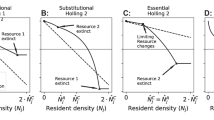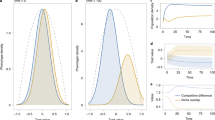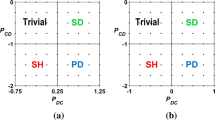Abstract
The current major models of coexistence of species on the same resources are briefly summarized. It is then shown that analysis of supposedly competitive systems in terms of the physical four dimensions of phase-space is sufficient to understand the causes for coexistence and for competitive exclusion. Thus, the multiple dimensions of niche theory are reduced to factors which define the magnitudes of the phase-spatial system, in particular the boundaries of population spaces and of periods of activity. Excluding possible cooperative interaction between consumers, it appears that coexistence of species on thesame kind of limiting resource is possible only in cases of compartmentalization either in space, or in time, of resource consumption, i.e. if each consumer species disposes of a separate resource supply. Three criteria were found to be decisive for successful compartmentalization (i.e. for coexistence): 1. the vector of the resource flow; 2. relative mobility between consumers and resource units; 3. dependence or independence of resource flow on previous consumption.
The traditional terminology of niche theory and of competition theory in general proved to be inadequate for analytical treatment of problems of coexistence.
Similar content being viewed by others
References
Arrigoni, M. and Steiner, A. (1987). Das Volterra'sche Konkurrenz-modell und die Selektionsgleichungen von Manfred Eigen. - Studia biophysica 118: 165–172.
Bollinger, B. (1982). Der modifizierte Jones'sche Hyperzyklus.-Diplomarbeit. Mathematisches Institut der Universität Zürich. 35 p.
Connor, E.F. and Simberloff, D. (1984) Neutral models of species co-occurrence patterns. In D.R. Strong et al., ed., Ecological communities, 316–331.- Princeton, New Jersey: Princeton Univ. Press.
Eigen, M. (1971). Self-organization of matter and the evolution of macromolecules.- Naturwissenschaften 58: 465–523.
Eigen, M. and Schuster, P. (1979). The hypercycle. A principle of natural self-organization.- Berlin, New York: Springer.
Gilpin, M.E. and Diamond, J.M. (1984). Are species co-occurrences on islands non-random, and are null hypotheses useful in community ecology? In D.R. Strong et al., ed. Ecological communities, 297–315.- Princeton, New Jersey: Princeton Univ. Press.
Hutchinson, G.E. (1957). Concluding remarks.- Cold Spring Harbour Symp. Quant. Biol. 22: 415–427.
Hutchinson, G.E. (1959). Homage to Santa Rosalia or: Why are there so many kinds of animals? - American Naturalist 93: 145–159.
Jones, B.L. (1977). A solvable hypercycle model for the selection of biological molecules.- J. math. Biol. 4: 187–193.
Lotka, A.J. (1932). The growth of mixed populations: two species competing for a common food supply.- J. Wash. Acad. Sci. 22: 461–469.
Maynard-Smith, J. (1978). Models in ecology.- London, New York: Cambridge University Press, 157 p.
McGhee, R. and Armstrong, R.A. (1977). Some mathematical problems concerning the ecological principle of competitive exclusion.- J. Diff. Equ. 23: 30–52.
Paine, R.T. (1984). Ecological determinism in the competition for space.- Ecology 65: 1339–1348.
Paine, R.T. and Levine, S.A. (1981). Intertidal landscapes: disturbance and the dynamics of pattern.-Ecological Monographs 51: 145–178.
Pianka, E.R. (1983). Evolutionary ecology. 3rd ed.- New York: Harper and Row, 416 p.
Pielou, E. C. (1975). Ecological diversity.- New York, Toronto: John Wiley and Sons Inc.
Slatkin, M. and Maynard-Smith, J. (1979). Models of coevolution.- Q. Rev. Biol. 54: 233–263.
Souza, W.P. (1979). Disturbance in marine, intertidal boulder fields: the non-equilibrium maintenance of species diversity.- Ecology 60: 1225–1239.
Tilman, D. (1977). Resource competition between planktonic algae: an experimental and theoretical approach.- Ecology 1977: 338–348.
Tilman, D. (1980). Resources: a graphical mechanistic approach to competition and predation.- Am. Nat. 116: 362–393.
Tilman, D., Kilham, S.S. and Kilham, P. (1982). Phytoplankton community ecology: the role of limiting nutrients.- Ann. Rev. Ecol. Syst. 13: 349–372.
Vandermeer, J.H. (1972). Niche theory.- Ann. Rev. Ecol. Syst. 3: 107–132.
Volterra, V. (1926). Variazioni e fluttuazioni del numero d'individui in specie animali conviventi.- Atti R. Acad. Naz. del Lincei 1: 1–85.
Volterra, V. (1931). Richerche matematiche sulle assoziazioni biologiche.- Estratto dal Giornale dell'Istituto Italiano degli Attuari 2/9, 65 p.
Walker, I. (1983). The physical dimensions and biological meaning of the coefficients in the Volterra competition equations and their consequences for the possibility of coexistence.- Acta biotheor. 32: 93–122.
Walker, I. (1984). The Volterra competition equations with resource-independent growth coefficients and discussion on their biological and biophysical implications.- Acta biotheor. 33: 253–270.
Walker, I. (1987). The biology of streams as part of amazonian forest ecology.- Experientia 43: 279–287.
Walker, I. and Williams, R.M. (1976). The evolution of the cooperative group.- Acta biotheor. 25: 1–43.
Author information
Authors and Affiliations
Rights and permissions
About this article
Cite this article
Walker, I. Compartmentalization and niche differentiation: causal patterns of competition and coexistence. Acta Biotheor 36, 215–239 (1987). https://doi.org/10.1007/BF02329784
Received:
Revised:
Issue Date:
DOI: https://doi.org/10.1007/BF02329784




